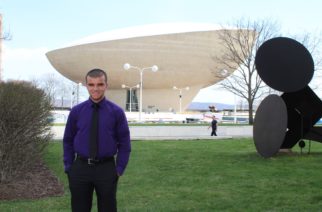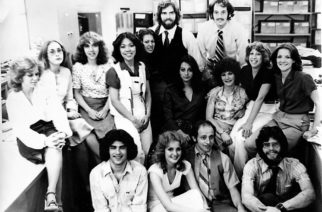
One day your life revolves around books and boring academic lectures. The next, you’re thrust into the real life epicenter of Empire State power and politics.
That’s how I felt as one of the scrappy college kids embarking on an internship covering the state Capitol. The Legislative Gazette was a one of kind program – combining academic, journalism, government and political intrigue.
I spent the spring and fall semesters of 1988 at the Gazette. It was a year filled with presidential hopefuls making pilgrimages to Albany and Gov. Mario Cuomo’s agonizing indecision over whether he would run for president. Al Sharpton and folk singer Pete Seeger led a protest against the state’s handling of the Tawana Brawley case. Republican Senate Majority Leader Warren Anderson announced his retirement.
As the newspaper’s chief photographer, I captured images of press conferences, politicians and protesters. Endless hours wandering around the brutalist architecture that makes up the Empire State Plaza.
I had a penchant for getting on the roofs of buildings, even convincing a window washer to let me photograph him from his scaffold platform while he cleaned the 42nd floor outside windows of the Corning Tower. An old bathroom in the Alfred E. Smith Office Building served as my makeshift darkroom where I developed my film and prints.
I also wrote stories. One of my reporting beats was Veterans’ Affairs and Albany Assemblyman Dick Conners was the committee chair. He would keep me in his office for hours regaling stories about his nearly 50 years in political office featuring characters like Dan O’Connell and Erastus Corning. Mario Cuomo often held informal press conferences in his Capitol office or could be found at a local park playing pick-up basketball with a stranger.
Unlike some of the other Spring ’88 interns arriving in Albany, I had a couple of years of newspaper experience at The Oracle (SUNY New Paltz). But even that didn’t prepare me for the daunting task of covering the labyrinth of New York’s bureaucracy, or the old-school newsman who would be our boss. Glenn Doty had the unenviable task of playing the role of editor/professor/mentor/enforcer for the misfit gang of student journalists. Today, I am still friends with Glenn and several of my fellow interns.
I took what I learned at The Legislative Gazette to other newspapers, eventually becoming the Capitol Bureau reporter for The Troy Record. I left journalism in 2001 for a writer/editor position in the New York State Assembly, where I currently work as the Director of Speaker’s Correspondence.
The journalism business has evolved drastically since my Gazette experience 30 years ago. Computers were new, cellphones were unheard of, cameras required film, Google was the local library, and newspapers were printed on actual paper.
I can’t begin to imagine what changes future Gazette interns will witness. No matter what career path they ultimately take, the internship offers students a truly unique firsthand experience. It helped my career in journalism and government, and I hope it continues to inspire others for decades to come.












